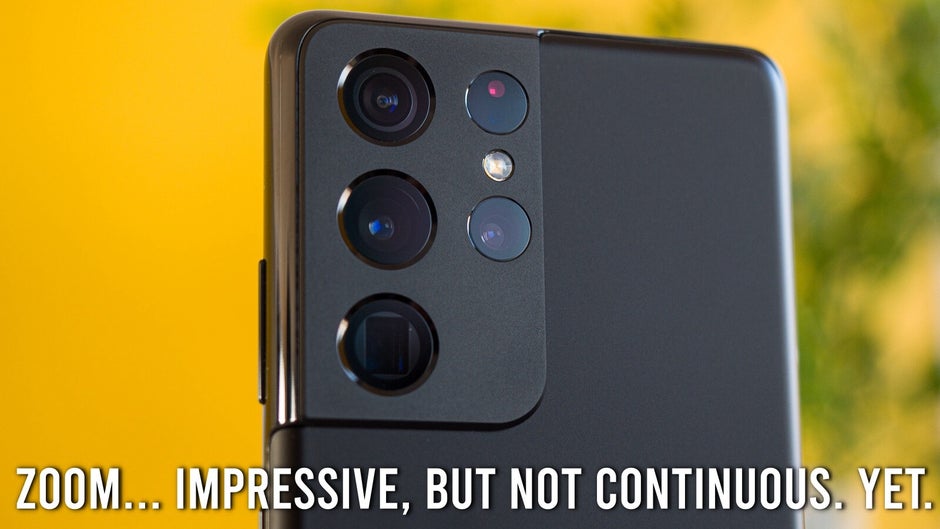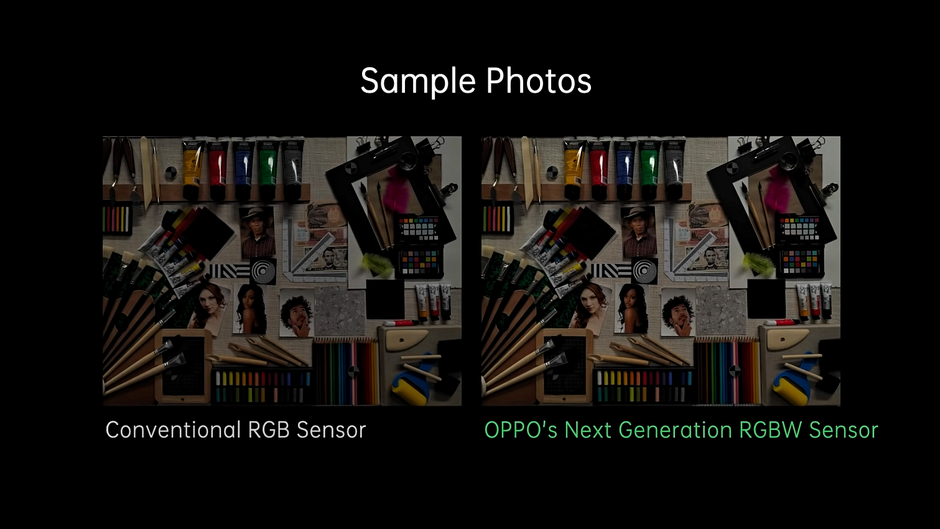Monumental: Oppo’s continuous optical zoom – a huge leap for smartphone cameras?
Surprise!
We knew Oppo was holding its “Future Imaging” event today, but we sure didn’t know what was coming. Before we get to the main dish, let’s give you a quick recap of what else Oppo introduced (we’ll talk about it in the second half of the story, found below):
- New under-display camera solution
- A unique new RGBW sensor
- Oppo’s Five-axis OIS
First things first: Oppo reveals its 85-200mm Continuous Optical Zoom camera system
- It adopts G+P (glass + plastic) lens technology for the first time, introducing two ultra-thin, high-precision aspheric glass lenses to significantly boost optical effects, such as minimizing stray light.
- The innovative application of a tunnel magnetoresistance sensor (TMR sensor) allows the lenses within the camera module to move with more stability and precision.
- The newly upgraded guiding shaft motor increases the dynamic tilt at which the lens system can be moved, easily supporting Continuous Optical Zoom at higher magnifications.
This solution is here to address issues known to everyone who’s ever tried using a multi-camera system.Take the Galaxy S21 Ultra – it has the most powerful camera system on any smartphone that goes like this:
- 0.5x (ultra-wide-camera)
- 1x (main camera sensor)
- 3x(standard telephoto)
- 10x (periscope)

Even the best can get much better.
However, any magnification that falls between those focal lengths (0.5x,1x,3x,10x) and beyond, will rely on digital zoom and sensor-cropping, which is effective, if you want a usable photo, but not ideal at all. On top of all, when jumping between lenses you see color shifting, white balance inconsistency, and worst of all – quality drop for mid-way magnification. Some phones are more prone to this than others, depending on the tuning.
For example, Apple’s iPhone 12 Pro series are the best when it comes to keeping the image consistent, and the switching between the three cameras is relatively smooth, although you can still clearly see drops in quality when you are mid-way (that’s unavoidable without continuous zoom).
This is why Oppo’s promise for continuous zoom in smartphones is monumental. I’d go as far as to say that once commercializd, this could be the biggest leap in smartphone photography ever, as far as hardware is concerned. Therefore, I’m so excited to see Oppo’s first take on continuous zoom, which was demonstrated today.
Sure, it’s not going to be easy to fit this large mechanism into the tiny body of a smartphone, but guess what – smartphones have been getting bigger and bigger anyway. Moreover, no one had thought that 5-10x optical zoom cameras will be possible either. However, Huawei proved everyone wrong with the P30 Pro, by fitting its periscope zoom camera system flat, and using mirrors to reflect the picture and send it to the camera sensor which wasn’t where it’s supposed to be at all.
Therefore, I’m positive we’ll see our first smartphone with continuous zoom in 2022! Is it going to be by Oppo? It’s likely. However, make no mistake – Xiaomi, Vivo, OnePlus, and of course, Samsung, aren’t going to sleep on that at all. For the record, we’ve already seen continuous zoom on a smartphone thanks to Samsung’s K Zoom and Panasonic’s CM1. However, these devices had the size of actual pocket cameras, and none of the modern-day image processing.
Now, back to the rest of the innovations from Oppo’s Future Imaging event:
New under-display camera solution which Oppo claims is “the best one yet”
This one was expected, since Oppo had teased it already. Under-display cameras are now becoming mainstream. We already have three globally-available (each one available in different regions of the world) smartphones with under-display camera to give you a true bezel-less display experience thanks to ZTE with the Axon 30 5G, Xiaomi with the Mix 4, and Samsung with the Galaxy Z Fold 3 (announced in that order). As far as Oppo’s first commercially available phone with UDC is concerned – we don’t know when it’s coming (yet).
New Sensor: the next-generation RGBW sensor enhances light sensitivity with improved color performance

Huawei did it over two years ago with the RYYB sensor in the P30 Pro.
Then, we have Oppo’s unique RGBW sensor for enhancing light sensitivity. It’s reminiscent of Huawei’s game-changing RYYB sensor that debuted on the (then) low-light champ, Huawei P30 Pro. At the time Huawei’s flagship was leaps and bounds ahead of the competition in low-light scenarios. However, Huawei’s phone had a slight but distinct yellowish tint, perhaps exactly thanks to the RYYB sensor which used Red-Yellow-Yellow-Blue filters as opposed to the traditional Red-Green-Blue.
Clearly, Oppo’s taken some inspiration from Huawei, but the truth is that RGBW sensors aren’t new. However, this might well be the best modern take on them. Oppo developed its own sensor, and then put its own twist on it in order to solve the color issues that come with such tech. Oppo’s RGBW – Red-Green-Blue-White solution promises better color accuracy, and up to 60% better light sensitivity to elevate low-light photography to new heights. More than just improving low-light photo capturing, the next-generation RGBW sensor is said to be able to make portraits more expressive in both photo and video with enhancements to skin, texture, and contrast. Oppo promises this tech will hit Oppo smartphones as soon as this year – Q4, 2021!
Brand new Oppo Five-axis OIS with Sensor-shift stabilization

According to Oppo, the person who’s riding the skadeboard is moving (duh), but the one who’s taking the video is also moving! If that’s the case, the five-axis OIS is damn impressive…
OPPO’s new Five-axis OIS technology promises to help improve stability, but also clarity, and color performance, which makes sense – the picture is easier to process when it’s more stable. Increasing the vibration compensation performance by up to 65%, Oppo’s Five-axis OIS is said to become commercially released early next year – Q1, 2022!
Watch the full Oppo Future Imaging event, where you’ll find more samples and demonstrations of the innovative camera tech introduced today:
For all the latest Technology News Click Here
For the latest news and updates, follow us on Google News.

